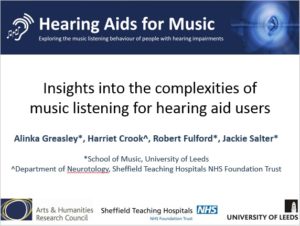Earlier this month, I flew to San Francisco to attend and present at the 14th International Conference on Music Perception and Cognition which is a biennial conference covering fields such as acoustics and psychophysics, aesthetic perception and response, musical development, music education, and music, health and well-being.
I presented findings from our first study (clinical questionnaire) which explored the extent of music listening issues and the frequency and success of discussions with audiologists about music. Data from 176 hearing aid (HA) users, aged 21 – 93 years old, showed that challenges with music listening were often experienced and almost half reported that this negatively affects their quality of life. Participants described issues listening to live music performances, hearing words in songs, the loss of music from their lives and associated social exclusion. The majority of participants had not discussed music with their audiologist. For those who had, some reported positive experiences wherein increased HA tailoring by the audiologist had enhanced music appreciation. Other experiences were less positive with no improvements reported. Results suggest that more could be done to help audiologists fit HAs for music and to inform HA users of their options. An overview of the results is available here.

I then discussed preliminary findings from our second study (in-depth interviews, with collection of audiometric data). Data from 22 HA users, aged between 24-82 years old, with varying levels of hearing impairment, highlighted the complexities of listening to music with hearing aids. Some of the problems encountered mirrored those found in our first study and in previous work (e.g. Chasin & Hockley, 2014; Madsen & Moore, 2014) such as distortion (particularly at higher frequencies), a reduction in tone quality, and challenges listening to music in live contexts. However, there were less problems with feedback and distortion than anticipated, and positively, several interviewees reported that they did not experience any difficulties when listening to music with their hearing aids. These individuals tended to be non-musicians with milder levels of hearing loss, but nonetheless were highly engaged with music in everyday life.
Results show differences in hearing aid use according to people’s level of hearing impairment, level of musical engagement and training, the musical style(s) being listened to, and the context(s) in which the music is being heard. This supports theorising by Hargreaves and colleagues (e.g. Hargreaves et al., 2006) which stipulates that responses to music are a result of interactions between listener, music and contextual variables. However, our data provide new insights into how levels of hearing impairment, and the type and functionality of the HA technology affect musical experiences. There were differences in interviewees’ understanding of their HA technology (musicians stood out as being the most informed) and in the process of acclimatising to the new sound world. Problems experienced appear to be mediated by general attitudes towards the HA technology. Some were proactive in adjusting, adapting, and experimenting, whereas others were less inclined to explore the possibilities. Across all participants, the use of Assistive Listening Devices (ALDs) was low which suggests that HA users are not as aware as they could be about what tools are out there that could help. These are just some preliminary findings. We are conducting an in-depth analysis of the dataset and will be able to report a fuller analysis in due course.
This event was attended by Alinka Greasley.

